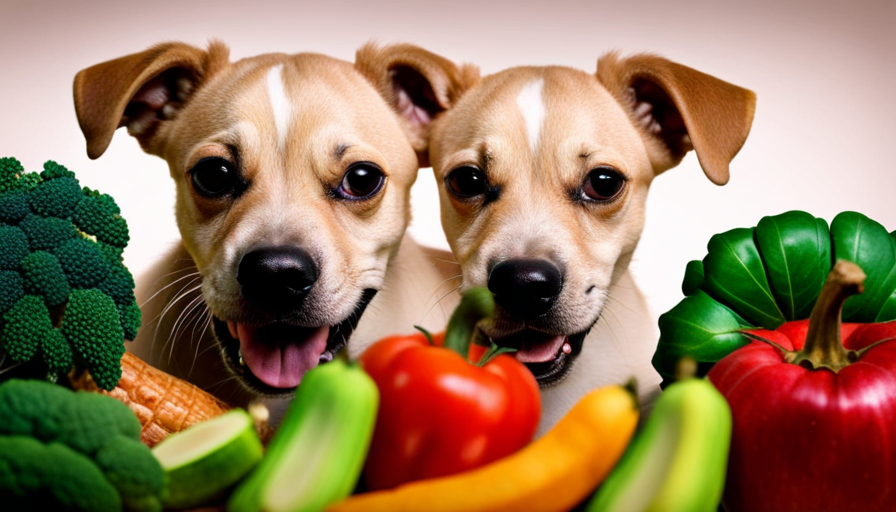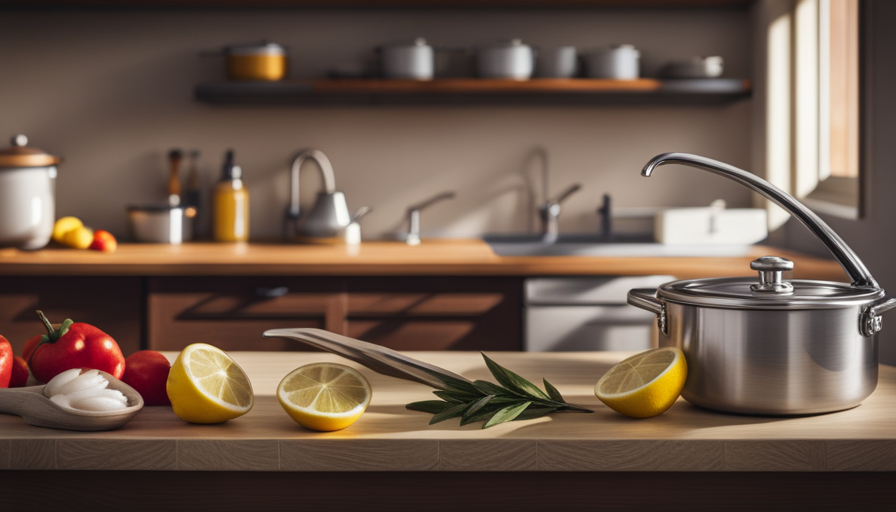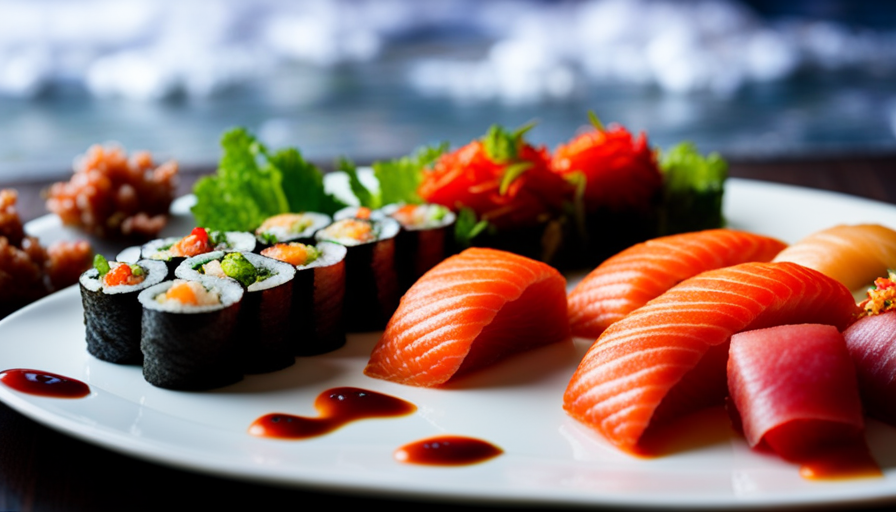Feeding puppies raw food is like serving them a high-quality meal that nourishes their bodies and satisfies their natural instincts. Just as a skilled chef carefully selects the finest ingredients and combines them expertly, you can create a raw food diet that promotes your pet’s overall health. Embracing this holistic approach will lead to your puppy thriving and developing.
In this article, we will guide you through the essential steps of feeding raw food to puppies. From understanding the advantages of a raw diet to selecting high-quality ingredients, ensuring nutritional balance, and introducing raw food gradually, we’ll cover it all.
We’ll also explore safety measures, the transition from commercial puppy food, and the importance of consulting with a veterinarian for expert guidance.
With our science-based tips and thorough guidance, you’ll gain the knowledge and confidence to embark on a successful long-term raw feeding journey with your precious puppy.
So let’s dive in and discover the art of nourishing your puppy with the utmost care and love.
Key Takeaways
- Feeding raw food to puppies provides numerous health benefits such as improved digestion, healthier skin and coat, increased energy levels, and stronger immune systems.
- Freshness and sourcing ethical ingredients are key factors in selecting high-quality ingredients for a raw puppy food diet.
- Proper nutritional balance in raw puppy meals includes a variety of proteins, adequate fat content, and balanced calcium and phosphorus levels.
- Introduce raw food to puppies gradually to avoid digestive upset, starting with a small portion and increasing over time.
Understanding the Benefits of a Raw Food Diet for Puppies
If you’re wondering why a raw food diet is so beneficial for your new furry friend, let me break it down for you!
Understanding the risks and potential drawbacks of a raw food diet for puppies is essential before making the switch. Raw food diets provide numerous health benefits for puppies, such as improved digestion, healthier skin and coat, increased energy levels, and stronger immune systems.
Feeding raw food to your puppy also means being mindful of finding reputable raw food suppliers. It’s crucial to ensure that the raw food you provide is of high quality, free from any contaminants or harmful bacteria. Look for suppliers who follow strict food safety protocols and have a good reputation within the raw food community.
Another consideration when feeding raw food to puppies is the cost. Raw food diets can be more expensive than traditional commercial dog food. This is due to the high-quality ingredients and the additional effort needed to prepare and store the food properly. However, many pet owners find that the long-term health benefits outweigh the initial costs.
Understanding the benefits of a raw food diet for puppies is important for their overall wellbeing. While there are potential risks and drawbacks, finding reputable suppliers and considering the cost can help ensure a successful transition to a raw food diet for your puppy.
Selecting High-Quality Ingredients for Raw Puppy Food
When choosing the best ingredients for your furry friend’s raw diet, it’s crucial to prioritize high-quality options. Evaluating the freshness and sourcing ethical ingredients are key factors in ensuring your puppy gets the nutrition they need.
Freshness is important because raw food can spoil quickly, leading to potential health risks for your pup. Look for ingredients that are sourced from reputable suppliers and have clear information about their handling and storage practices.
To evaluate freshness, pay attention to the appearance, smell, and texture of the ingredients. Fresh meat should have a vibrant color, while organs should be firm and not slimy. Additionally, the ingredients should have a pleasant smell, without any signs of spoilage.
It’s also important to consider the source of the ingredients. Look for suppliers that prioritize ethical practices, such as raising animals in a natural and humane environment.
Sourcing ethical ingredients ensures that the animals used for the raw food diet are treated well and that their meat is of higher quality. Look for ingredients that are sourced from humanely raised animals, free from antibiotics and hormones. This not only benefits your puppy’s health but also supports sustainable and responsible farming practices.
By selecting high-quality ingredients for your puppy’s raw food diet, you can provide them with the best nutrition possible while also supporting ethical and sustainable practices in the food industry.
Ensuring Proper Nutritional Balance in Raw Puppy Meals
To ensure your furry friend’s raw diet is nutritionally balanced, it’s essential to carefully consider the ingredients you include in their meals. Ensuring proper nutritional balance in raw puppy meals is crucial for their growth and development.
Here are three key factors to keep in mind:
-
Variety of proteins: Including a variety of high-quality proteins in your puppy’s raw meals is important to provide all the essential amino acids they need. Consider including sources like lean meats, fish, and organ meats. These proteins aren’t just rich in essential nutrients but also promote healthy muscle development.
-
Adequate fat content: Healthy fats are an essential part of a puppy’s diet as they provide energy and support brain development. Include fats from sources like salmon oil or flaxseed oil, which are high in omega-3 fatty acids. These fats have anti-inflammatory properties and contribute to a shiny coat and healthy skin.
-
Balanced calcium and phosphorus levels: Puppies require the right balance of calcium and phosphorus for proper bone growth. Including ingredients like raw meaty bones or ground eggshells can help achieve this balance. However, it’s crucial to consult with a veterinarian to ensure the correct ratios are maintained to prevent skeletal issues.
By carefully selecting a variety of proteins, including adequate fats, and balancing calcium and phosphorus levels, you can ensure that your puppy’s raw meals are nutritionally balanced. Remember, consulting with a veterinarian is essential to tailor the diet to your puppy’s specific needs and ensure optimal growth and development.
Introducing Raw Food to Puppies Gradually
Introducing raw meals to young canines can be a game-changer, ensuring their taste buds embark on a sensational journey of delectable, nutrient-packed goodness. When transitioning puppies to a raw food diet, it’s important to do it gradually to avoid any digestive upset.
Start by replacing a small portion of their regular food with raw food and slowly increase the amount over time. This gradual transition allows their bodies to adjust to the new diet without any discomfort.
There are many benefits to feeding puppies raw food. Firstly, it provides them with a wide range of essential nutrients that support their growth and development. Raw food is rich in vitamins, minerals, and enzymes that are often lost during the cooking process. It also contains natural proteins and healthy fats, which are important for building strong muscles and promoting a shiny coat.
Additionally, raw food can improve digestion and reduce the risk of allergies in puppies. The enzymes present in raw food help break down the nutrients more efficiently, leading to better absorption and fewer digestive issues. Furthermore, feeding puppies raw food can strengthen their immune system, making them less susceptible to common health problems.
Introducing raw food to puppies gradually allows them to experience the numerous benefits it offers. By providing them with a nutrient-dense diet, you’re setting them up for a healthy and vibrant life. So, take the time to make a gradual transition and watch your puppy thrive on their new raw food journey.
Monitoring Your Puppy’s Health and Well-being on a Raw Food Diet
Keeping a close eye on your furry friend’s overall condition and happiness is crucial while they enjoy the benefits of a raw diet. As your puppy transitions to a raw food diet, it’s important to monitor their weight management and adjust portion sizes accordingly.
Weight management is essential for your puppy’s health and well-being. Raw food diets can be tailored to meet your puppy’s specific nutritional needs, but it’s important to ensure they’re not gaining or losing weight too quickly. Regularly weigh your puppy and consult with your veterinarian to determine the appropriate portion sizes. Adjust the amount of food you’re feeding based on their weight and body condition.
In addition to monitoring weight, keep an eye on your puppy’s overall health and well-being. Look for signs of increased energy, a shiny coat, and healthy teeth and gums. Any changes in their behavior, such as lethargy or digestive issues, should be addressed promptly. It’s also important to monitor their stool quality, as this can be an indicator of how well they’re digesting and utilizing the raw food.
Remember, every puppy is unique, and their nutritional needs may vary. Regularly assess their weight and adjust portion sizes as needed to ensure they’re thriving on their raw food diet. By closely monitoring their health and well-being, you can ensure that your puppy is getting the most out of their raw food diet.
Addressing Common Concerns and Misconceptions about Feeding Raw Food to Puppies
One might think that giving puppies a taste of nature’s bounty is like opening a Pandora’s box of health risks, but let’s debunk some of the common concerns and misconceptions surrounding the nourishment of our furry friends.
-
Raw food is unsafe for puppies: Contrary to popular belief, raw food can be a safe and healthy option for puppies. When prepared and handled properly, raw food can provide essential nutrients for your growing pup.
-
Raw food is superior to kibble for puppies: While both raw food and kibble can provide a balanced diet, raw food offers several benefits. It can improve digestion, promote healthier skin and coat, and provide a more natural and varied diet for your puppy.
-
Raw food diets lack essential nutrients: Raw food diets can be nutritionally balanced when carefully planned. They should include a variety of proteins, fruits, vegetables, and supplements to ensure your puppy receives all the necessary nutrients for optimal growth and development.
-
Raw food diets are only for adult dogs: Raw food diets are suitable for puppies as well. In fact, starting a puppy on a raw food diet from a young age can set the stage for a lifetime of good health and prevent common health issues associated with processed foods.
Remember, it’s important to consult with your veterinarian before making any dietary changes for your puppy. They can provide guidance and help you create a balanced and appropriate raw food diet for your furry friend.
Raw Food Safety Measures for Puppies
Now that we’ve addressed common concerns and misconceptions about feeding raw food to puppies, let’s dive into the important topic of raw food safety measures.
When it comes to preparing raw food for your furry friend, it’s crucial to take certain precautions to ensure their health and well-being.
First and foremost, it’s essential to handle raw food with the same level of care as you would when preparing food for yourself. This includes washing your hands thoroughly before and after handling raw meat to prevent the spread of bacteria. Additionally, make sure to clean all surfaces and utensils that come into contact with the raw food to avoid cross-contamination.
Another vital safety measure is to source high-quality raw meat from trusted suppliers. This minimizes the risk of contamination and ensures that your puppy is getting the necessary nutrients. Remember to store raw food properly in the refrigerator or freezer to maintain its freshness and prevent the growth of harmful bacteria.
Lastly, be aware of the potential risks associated with feeding raw food to puppies. Raw meat can contain bacteria such as Salmonella or E. coli, which can cause serious illnesses in both dogs and humans. Therefore, it’s crucial to monitor your puppy’s health closely and consult with a veterinarian if you notice any signs of digestive issues or illness.
By following these raw food safety measures, you can provide your puppy with a balanced and nutritious diet while minimizing the potential risks.
Transitioning from Commercial Puppy Food to a Raw Diet
Transitioning from commercially prepared puppy food to a raw diet can be a gradual process that allows your furry companion to adapt to the new feeding routine. It’s important to understand that this transition may present some challenges, but with the right approach, you can ensure a smooth shift.
To begin the transitioning process, start by introducing small amounts of raw food alongside your puppy’s regular diet. This will help their digestive system adjust to the new food gradually. Over time, gradually increase the proportion of raw food while decreasing the commercial puppy food. This slow transition allows their body to adapt to the new diet without causing any digestive upset.
One potential challenge during this process is that your puppy may initially resist the raw food. They may be accustomed to the taste and texture of commercial puppy food, so it might take some time for them to develop a liking for raw food. Be patient and persistent, offering a variety of raw meats, bones, and organs to cater to their preferences.
Another challenge could be ensuring a balanced diet. When feeding raw, it’s crucial to provide a variety of proteins, including muscle meat, bones, and organs, to meet your puppy’s nutritional needs. Consult with a veterinarian or a professional experienced in raw feeding to ensure your puppy receives all the necessary nutrients.
By taking a gradual approach and addressing any potential challenges, you can successfully transition your puppy from commercial puppy food to a raw diet. Remember to monitor their health and well-being throughout the process and make adjustments as needed.
Consulting with a Veterinarian for Guidance on Feeding Raw Food to Puppies
To ensure the best guidance on introducing a raw diet to your puppy, it’s essential to consult with a veterinarian who can provide personalized advice tailored to your furry friend’s needs. A veterinarian’s expertise is invaluable when it comes to making dietary changes for your puppy, as they can evaluate their current health status and determine if a raw diet is appropriate.
When consulting with a veterinarian about feeding raw food to your puppy, it’s important to discuss the potential risks associated with this type of diet. While raw diets can offer benefits such as improved digestion and healthier skin and coat, there are also risks to consider. These include the potential for bacterial contamination, nutritional imbalances, and an increased risk of certain health issues.
Incorporating a 3 column and 4 row table can help you understand the pros and cons of feeding raw food to your puppy:
| Pros | Cons |
|---|---|
| Improved digestion | Bacterial contamination |
| Healthier skin and coat | Nutritional imbalances |
| Potential for weight control | Increased risk of health issues |
By consulting with a veterinarian, you can gain a better understanding of these potential risks and how to minimize them. Your veterinarian can guide you on proper food handling, sourcing high-quality ingredients, and ensuring a balanced diet that meets your puppy’s specific nutritional needs. Remember, the health and well-being of your puppy should always be the top priority, and consulting with a veterinarian is key to making informed decisions about their diet.
Tips for Successful Long-Term Raw Feeding for Puppies
When embarking on a long-term journey of nourishing your furry companions with a natural and unprocessed diet, it’s essential to consider certain tips for success. One important aspect is the transitioning process. It’s crucial to introduce raw food gradually to avoid any digestive upsets. Start by mixing a small amount of raw food with their current diet, and gradually increase the ratio over a period of one to two weeks. This allows their digestive system to adapt to the new diet without any issues.
Another vital consideration is the age requirements for feeding raw food to puppies. It’s generally recommended to wait until puppies are at least eight weeks old before introducing raw food. This is to ensure that their digestive system is developed enough to handle the raw diet properly. However, it’s always best to consult with your veterinarian to determine the best time to start raw feeding based on your puppy’s specific needs.
Furthermore, it’s important to ensure a balanced and complete diet for your growing puppies. This means including a variety of different meats, bones, organs, and vegetables to provide all the necessary nutrients. Consulting with a veterinary nutritionist can be beneficial in formulating a well-balanced raw feeding plan tailored to your puppy’s specific requirements.
By following these tips, you can ensure a successful long-term raw feeding journey for your puppies, promoting their overall health and well-being.
Frequently Asked Questions
Can I feed my puppy a raw food diet if they have specific dietary restrictions or allergies?
Feeding raw food to puppies with dietary restrictions or allergies: Is it safe?
When it comes to managing dietary restrictions or allergies in puppies, a raw food diet can be challenging. It’s important to consult with a veterinarian to ensure your puppy’s nutritional needs are being met. They can help you create a balanced diet that avoids triggering any allergies or exacerbating dietary restrictions.
Additionally, introducing new foods gradually and monitoring your puppy’s response is crucial to their health and well-being.
How often should I feed my puppy on a raw food diet?
To ensure your puppy thrives on a raw food diet, it’s important to establish a feeding schedule. Begin by gradually transitioning them, mixing small amounts of raw food with their current diet. This will help prevent digestive upset. It’s essential to include a variety of proteins, fruits, vegetables, and supplements to balance nutrients. Consult with a veterinarian or canine nutritionist to ensure your puppy gets all the necessary nutrients for optimal health.
Are there any supplements that I need to add to my puppy’s raw food diet?
To ensure your puppy’s raw food diet is balanced, there are several supplement options available. These supplements can help provide essential nutrients that may be lacking in a raw food diet.
Some common supplements include omega-3 fatty acids for healthy skin and coat, probiotics for gut health, and calcium for proper bone development.
Adding these supplements to your puppy’s raw food diet can help maximize the benefits of this nutritious feeding approach.
Can I still give my puppy treats or snacks while they are on a raw food diet?
Absolutely! While feeding your puppy a raw food diet, you can still give them treats or snacks. However, it’s important to choose options that align with their dietary needs.
Think of it as puppy training with a twist! Instead of traditional treats, you can use small portions of raw meat or vegetables as rewards. This not only keeps your puppy motivated during training but also ensures they stay on track with their raw food diet.
What do I do if my puppy refuses to eat the raw food?
If your puppy refuses to eat the raw food, don’t fret! Dealing with picky eaters is common.
First, ensure the food is fresh and properly prepared. If your pup still refuses, consider alternative feeding options like lightly cooking the food or incorporating some high-quality wet food.
Gradually transition to raw food by mixing it with their current diet. Remember, it’s important to consult with a veterinarian before making any changes to your puppy’s diet.
Are the Same Raw Food Principles Applied to Feeding Puppies and Ferrets?
Feeding ferrets raw food diet requires specific considerations that may not be the same as feeding puppies. While both can benefit from a raw food diet, ferrets have a higher protein requirement and need a diet rich in animal-based proteins, fats, and minimal carbohydrates compared to puppies.
Conclusion
In conclusion, feeding raw food to puppies can provide numerous benefits for their health and overall well-being. It’s important to select high-quality ingredients and ensure proper nutritional balance in their meals. Gradual introduction and monitoring of their health is crucial.
Following safety measures and transitioning from commercial puppy food to a raw diet can be a smooth process with guidance from a veterinarian. Did you know that a study found that puppies fed a raw food diet had significantly higher levels of Omega-3 fatty acids, which can contribute to their brain development and overall cognitive function?
So, consider giving your puppy the best start in life with a raw food diet.










